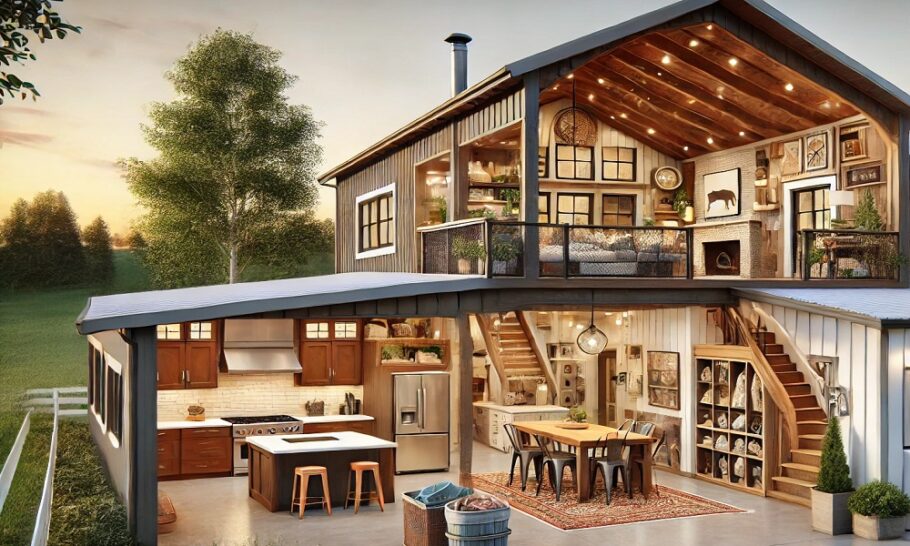When it comes to designing a barndominium, the conversation often starts with aesthetics—open floor plans, soaring ceilings, and custom finishes. But any structural engineer will tell you that what truly makes or breaks a building is something most homeowners rarely see: the foundation.
Two of the most common foundation systems for barndominiums are slab-on-grade and stem wall foundations. While both provide stability, durability, and a base for construction, they perform differently depending on soil conditions, climate, load demands, and long-term homeowner goals. From an engineering perspective, choosing the right foundation is about striking a balance between structural performance, cost-effectiveness, and adaptability to site conditions.
In this article, we’ll break down both systems, evaluate their strengths and weaknesses, and discuss how to determine the best choice for your barndominium.
Understanding the Two Systems
What is a Slab-on-Grade Foundation?
A slab-on-grade foundation is exactly what it sounds like: a single, thick concrete slab poured directly on the ground. Typically, the edges are thicker (acting as grade beams), while the interior slab is reinforced with rebar or welded wire mesh. The concrete is placed on top of compacted gravel and a vapor barrier, with the entire slab acting as both the foundation and the floor system.
Slab-on-grade is the most common foundation system for barndominiums due to its relative affordability and speed of construction.
Key features:
- Concrete slab poured directly on prepared soil or fill.
- Thickened perimeter edge (may serve as footing).
- Minimal excavation required.
- Slab doubles as finished floor or base for flooring.
What is a Stem Wall Foundation?
A stem wall foundation consists of continuous footings below grade, with concrete or masonry walls extending upward to create a crawlspace or to support a slab elevated above ground level. The slab (if included) is then poured on top of compacted fill inside the stem walls.
This method separates the structural support (footings and walls) from the slab itself, which can reduce cracking risks and accommodate uneven terrain more effectively.
Key features:
- Continuous concrete footings below frost line.
- Short vertical walls (“stem walls”) rise from the footing.
- Slab poured inside the stem walls, or a framed floor system spans across.
- Provides elevation above grade, protecting against moisture and pests.
Comparing Slab-on-Grade vs. Stem Wall
From an engineering standpoint, the two systems differ in how they handle soil, moisture, loads, and climate conditions. Let’s look at their strengths and weaknesses side by side.
- Soil Conditions and Bearing Capacity
- Slab-on-Grade: Works best on stable, well-compacted soils with minimal expansion or contraction. On expansive clays or poorly compacted fill, slabs are prone to differential settlement and cracking. Mitigation may require soil stabilization, post-tensioning, or thicker slabs.
- Stem Wall: More forgiving in areas with expansive clay, sandy soils, or sloped terrain. Because loads are transferred through continuous footings below grade, the foundation is less vulnerable to surface-level soil movement.
Engineer’s note: If your geotechnical report reveals expansive clay or inconsistent fill, a stem wall foundation provides more reliable long-term performance.
- Climate Considerations
- Slab-on-Grade: Popular in warmer climates where frost depth is minimal. In cold climates, slab-on-grade requires insulation and sometimes frost-protected shallow foundation (FPSF) design to prevent frost heave.
- Stem Wall: Better suited for regions with deep frost lines. By extending footings below frost depth, stem walls prevent heaving. They also provide an elevated floor system in flood-prone areas.
Engineer’s note: For barndominiums in northern states with harsh winters or coastal areas with flood exposure, stem walls are often the safer bet.
- Moisture and Drainage
- Slab-on-Grade: Slabs rest directly on the ground, making them vulnerable to moisture infiltration, especially if the vapor barrier or site drainage is poorly designed. This can cause mold, flooring damage, or slab curling.
- Stem Wall: Elevates the slab above grade, providing better protection against ground moisture, flooding, and termite intrusion. The crawlspace (if included) allows for mechanical systems to be housed safely off the ground.
Engineer’s note: In areas with high water tables or poor drainage, stem walls add resilience and peace of mind.
- Structural Load Capacity
- Slab-on-Grade: Adequate for most barndominiums, particularly when post-frame or steel-frame construction is used. Heavy concentrated loads (like interior columns supporting lofts or large machinery) may require thickened pads.
- Stem Wall: Offers greater flexibility for distributing loads, especially when integrating masonry or steel superstructures. Footings can be engineered to handle concentrated point loads more effectively.
- Construction Speed and Cost
- Slab-on-Grade: Faster and generally less expensive. Fewer materials and less excavation reduce both labor and timeline. However, costs may rise significantly if soil stabilization or advanced reinforcement is required.
- Stem Wall: More expensive due to additional excavation, concrete, masonry, and labor. Timelines are longer since footings, walls, and slabs are poured in stages.
Engineer’s note: For flat, stable sites in mild climates, slab-on-grade often wins on cost-efficiency.
- Accessibility and Future Flexibility
- Slab-on-Grade: Mechanical systems (plumbing, electrical conduits) must be embedded in or below the slab. This makes future modifications difficult and expensive.
- Stem Wall: Crawlspaces or elevated interiors allow easier access for maintenance and retrofits. This flexibility can be invaluable for long-term homeowners planning expansions or upgrades.
- Aesthetics and Comfort
- Slab-on-Grade: Can feel colder underfoot without radiant floor heating or insulation. Flooring materials must account for slab movement and moisture.
- Stem Wall: Elevated living spaces create a more traditional “house-like” aesthetic, with options for crawlspace ventilation and better insulation performance.
Case Studies: When Each Works Best
- Slab-on-Grade Ideal Scenario
- Location: Central Texas.
- Soil: Well-drained sandy loam.
- Climate: Mild winters, minimal frost.
- Project: Single-story, steel-frame barndominium with large shop space.
- Outcome: Slab-on-grade proved cost-effective and quick, with little risk of settlement.
- Stem Wall Ideal Scenario
- Location: Colorado Front Range.
- Soil: Expansive clay.
- Climate: Harsh winters, deep frost line.
- Project: Two-story barndominium with loft and masonry veneer.
- Outcome: Stem wall allowed footings below frost depth, stabilized load transfer, and elevated living space above ground moisture.
Professional Recommendation: Which One Should You Choose?
From an engineering perspective, the best foundation for your barndominium depends on your site’s soil report, climate, and intended use of the building.
- Choose Slab-on-Grade if:
- You’re building on stable, well-drained soil.
- Your site is relatively flat.
- You want faster, more affordable construction.
- You’re in a warm climate with minimal frost concerns.
- Choose Stem Wall if:
- You’re building on expansive clay, poorly compacted fill, or sloped terrain.
- You’re in a region with frost heave or flooding risks.
- You want long-term flexibility for mechanical systems.
- You’re planning a two-story barndominium or heavy load structures.
Final Thoughts
Barndominiums are unique in that they blend residential comfort with structural demands similar to commercial or agricultural buildings. That makes foundation design especially critical.
Ultimately, both slab-on-grade and stem wall foundations can perform exceptionally well when designed correctly for their environment. By aligning your choice with soil conditions, climate factors, and long-term goals, you’ll ensure your barndominium stands strong for decades to come.

